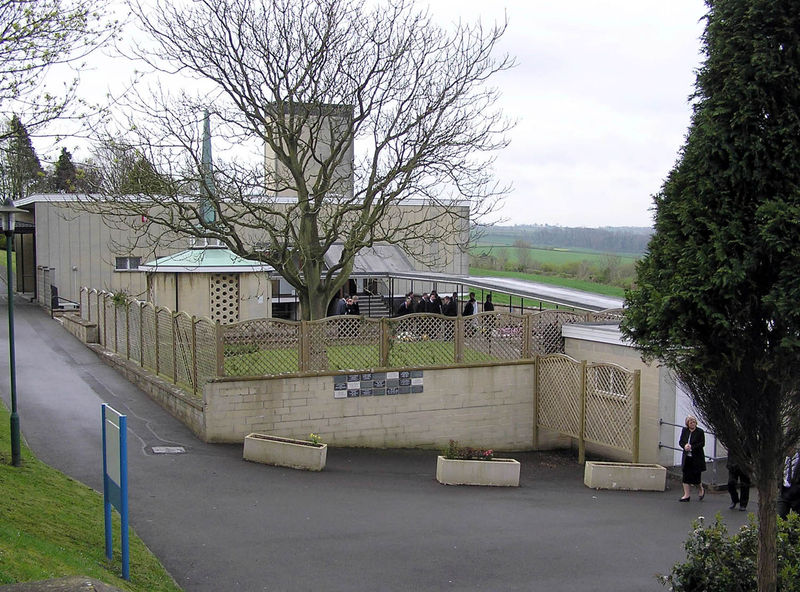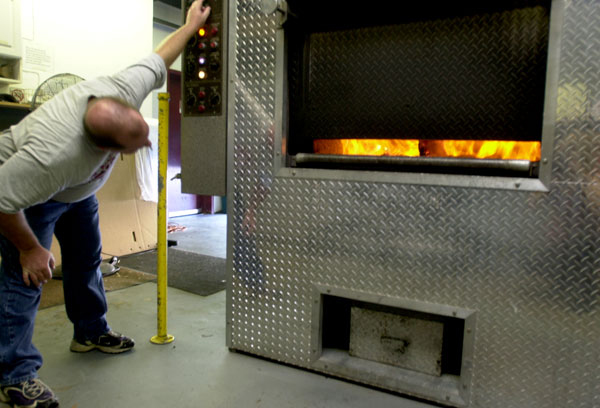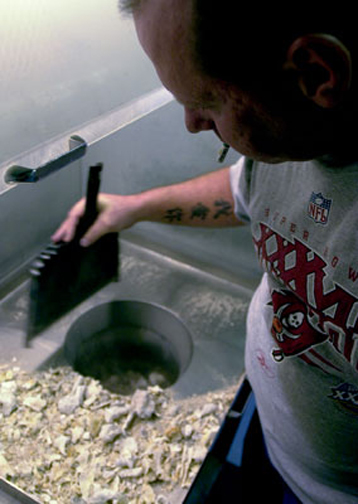
|

|

Cremation is the act of reducing a corpse by burning, generally
in a crematorium furnace or crematory fire. Contrary to popular belief, the remains are not ashes, but rather bone fragments
which are then crushed in a device called a cremulator. In funerals, cremation can be an alternative funeral rite to the burial
of a body in a grave.
The cremation occurs in a 'crematorium' consisting of one or more
cremator furnaces or cremation 'retorts' for the ashes. A cremator is an industrial furnace capable of generating 870-980
°C (1600-1800 °F) to ensure disintegration of the corpse. A crematorium may be part of chapel or a funeral home, or part of
an independent facility or a service offered by a cemetery.
Modern cremator fuels include natural gas and propane. However,
coal or coke were used until the early 1960s.
Modern cremators have adjustable control systems that monitor the
furnace during cremation.
A cremation furnace is not designed to cremate more than one body
at a time, which is illegal in many countries including the USA.
The chamber where the body is placed is called the retort. It is
lined with refractory brick that retains heat. The bricks are typically replaced every five years due to heat stress.
Modern cremators are computer-controlled to ensure legal and safe
use, e.g. the door cannot be opened until the cremator has reached operating temperature. The coffin is inserted (charged)
into the retort as quickly as possible to avoid heat loss through the top-opening door. The coffin may be on a charger (motorised
trolley) that can quickly insert the coffin, or one that can tilt and tip the coffin into the cremator.

Some crematoria allow relatives to view the charging. This is sometimes done for religious reasons, such
as traditional Hindu and Jain funerals.
Most cremators are a standard size. Typically, larger cities have access to an oversize cremator that can
handle deceased in the 200+ kg range (441 pounds). However, the obese cannot always be accommodated and must be buried instead.
Most large crematoriums have a small cremator installed for the disposal of fetal remains, babies and infants.
Body container
The remains are then sifted through to make sure the fragments
are small enough.
A body ready to be cremated is first placed in a container for cremation, which can be a simple corrugated
cardboard box or a wooden casket. Most casket manufacturers provide a line of caskets specially built for cremation. Another
option is a cardboard box that fits inside a wooden shell designed to look like a traditional casket. After the funeral service
the interior box is removed from the shell before cremation, permitting the shell to be reused. Funeral homes may also offer
rental caskets, which are traditional caskets used only for the duration of the services, after which the body is transferred
to another container for cremation. Rental caskets are sometimes designed with removable beds and liners, replaced after each
use.

In the UK, the body is not removed from the coffin, and is not placed
into a container as described above. The body is cremated with the coffin, which is why all UK coffins that are to be used
for cremation must be made of combustible material. The Code Of Cremation Practice forbids the opening of the coffin once
it has arrived at the crematorium, and rules stipulate it must be cremated on the same day as the funeral service. Therefore,
if a corpse is to be cremated in the UK, it will be done so in the same coffin as it is placed in at the funeral parlour.
Jewellery is strongly advised to be removed before the coffin is sealed, as the coffin cannot be opened once it has been received
at the crematorium. After the cremation process has been completed, the remains are passed through a magnetic field to remove
any bits of metal, which will be interred elsewhere in the crematorium grounds.
In Australia, the deceased are cremated in a coffin supplied by the undertaker. Reusable or cardboard coffins
are unknown. If cost is an issue, a plain, particle-board coffin known in the trade as a 'chippie' will be offered. Handles
(if fitted) are plastic and approved for use in a cremator. Coffins vary from unfinished particle board (covered with a velvet
pall if there is a service) to solid timber. Most are veneered particle board.
Cremations can be 'delivery only' with no preceding chapel service at the crematorium (although a church
service may have been held) or preceded by a service in one of the crematorium chapels. Delivery-only allows crematoriums
to schedule cremations to make best use of the cremators, perhaps by holding the body overnight in a refrigerator. As a result
a lower fee is applicable. Delivery-only may be referred to by industry jargon such as 'west chapel service'.

Burning and ashes collection
Remains with large pieces are put into a machine,
the 'cremulator', that grinds them down to finer bone fragments somewhat resembling wood-ash in appearance, but of greater
density.
The box containing the body is placed in the retort and incinerated at a temperature of 760 to 1150 °C (1400
to 2100 °F). During the cremation process, a large part of the body (especially the organs) and other soft tissue are vaporized
and oxidized due to the heat, and the gases are discharged through the exhaust system. The entire process usually takes about
two hours.
All that remains after cremation are dry bone fragments (mostly calcium phosphates and minor minerals).
These represent roughly 3.5% of the body's original mass (2.5% in children, but these figures vary greatly due to body composition).
Because the weight of dry bone fragments is so closely connected to skeletal mass, their weight varies greatly from person
to person, with the mean weight in a Florida, U.S. sample being 5.3 lb (approx. 2.4 kg) for adults (range 2 to 8 lb/900 g
to 3.6 kg). This is distributed bimodally, with the mean being 6 lb (2.7 kg) for men (range 4 to 8 lb/1.8 kg to 3.6 kg) and
4 lb (1.8 kg) for women (range 2 to 6 lb/900 g to 2.7 kg). In this sample, generally all adult cremated remains over 6 lb
(2.7 kg) were from males, and those under 4 lb (1.8 kg) were from females.
Jewelry, such as wristwatches and rings, are ordinarily removed and returned to the family. The only non-natural
item required to be removed is a pacemaker, as a pacemaker could explode and damage the cremator. In the United Kingdom, and
possibly other countries, the undertaker is required to remove pacemakers prior to delivering the body to the crematorium,
and sign a declaration stating that any pacemaker has been removed.

After the incineration is completed, the bone fragments are swept out of the retort, and the operator uses
a pulverizer called a cremulator (also known informally as a crembola) to process them into what are known as cremains which
exhibit the appearance of grains of sand (note that this varies with the efficiency of the cremulator used, and recognizable
chips of very dry bone may be seen in some final product cremated remains, depending on origin and facility). Cremulators
usually use some kind of rotating or grinding mechanism to powder the bones, such as the heavy metal bearings on older models.
In Japan and Taiwan, the bones are not pulverized unless requested beforehand, and are collected by the
family.
This is one of the reasons cremated remains are called ashes although a technical term sometimes used is
"cremains" (a portmanteau of "cremated" and "remains"). The ashes are placed in a container, which can be anything from a
simple cardboard box to a fancy urn. An unavoidable consequence of cremation is that a tiny residue of bodily remains is left
in the chamber after cremation and mixes with subsequent cremations.
Not all that remains is bone. There will be melted metal lumps from missed jewellery, casket furniture,
and dental fillings, and surgical implants such as hip replacements. Large items such as titanium hip replacements are usually
removed before grinding, as they may damage the grinder. After grinding, smaller bits of metal are sieved out and later interred
in common, consecrated ground in a remote area of the cemetery.
The pyre alternative
An alternative method used in some cultures, such as Hinduism and Jainism, is burning the corpse on a pyre.
A pyre is a pile of wood upon or within which the deceased's body is placed. The mound is lit on fire, the fire consumes the
wood and the deceased. This method was used in antiquity, as in the Iliad. This method is not commonly found in the western
world where crematorium furnaces are used, and is forbidden by law in some countries.
Source Wikipedia
|

|

|

